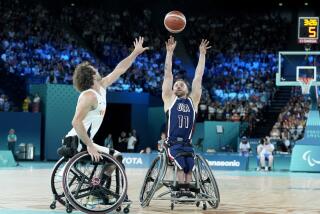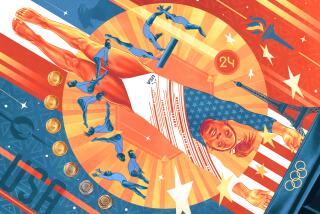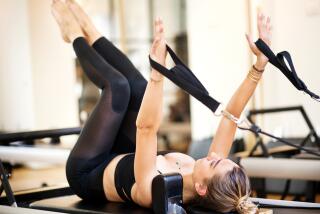If you’ve got it bad, they’ve got it worse
CORINA GILL
WATCHING dancer Corina Gill effortlessly rise on point, standing on one’s toes looks easy. Then she begins talking about the toll her feet take in satin shoes that provide precious little barrier between floor and foot.
The dancer with the Los Angeles Ballet has sustained plantar fasciitis (inflammation of the thick tissue that spans the bottom of the foot), Achilles tendinitis (inflammation of the Achilles tendon), bruises on her big toes, blisters, lost nails and bunions. But like all dancers, the 25-year-old from Garden Grove has learned to tolerate the pain, all the while taking care of her feet as best she can. She employs a variety of remedies, including something called an Ouch Pouch pad to cushion her forefoot and flexible polymer spacers that fit between the toes to help protect against bunions.
“If I feel something starting to hurt, even just a little bit,” she says, “I’ll take it easy and try not to do whatever makes it hurt -- unless I’m performing and I can’t do anything about it. The most important thing is not getting injured.”
Gill religiously uses elastic exercise bands on her feet, wrapping the band around the bottom of a foot, then flexing and pointing it. “It strengthens and warms it up,” she explains, “and I think it increases the mobility a little bit.”
Her feet, she says, “are like my musical instrument. You have to treat them with respect and care for them. You’ve only got one pair.”
PETER VAGENAS
WHEN soccer player Peter Vagenas took up yoga four years ago, he figured it would help his back but never expected it would also help his feet and ankles.
Ankle strains and sprains have plagued Los Angeles Galaxy midfielder Vagenas since college, but since taking up yoga he’s feeling more resilient. “You find it has to do with core stability,” he says. “A lot of times you’re on one leg and pretty much stabilizing yourself with that one ankle.” Being balanced helps while running and kicking, but also when being tackled by an opposing player, which happens frequently and can result in a sprained ankle.
Other than ankle injuries, the 28-year-old Angeleno has also been through blisters and lost nails, yet still has to play when his big toe is nail-less. He diligently ices his feet and ankles after practices and games to reduce any swelling and alleviate soreness. When the playing season ends, he takes time off and rests his feet as much as he can: “That’s just as important sometimes as working out,” he says.
When not in soccer cleats, his feet can be found in his favorite pair of 5-year-old Chilean casual shoes, or Crocs. “I even bought some for the training staff,” he says.
About his feet, Vagenas says: “They’re the way I’ve made my living and I’ve found something that I love to do. You do take them for granted, but then every once in a while you see someone who sustains an injury and it’s a two- or three-year process trying to get it corrected. That’s why I try to take good care of them.”
SHAY MURPHY
IT’S been a tough college career, foot-wise, for Shay Murphy. The 21-year-old member of the USC women’s basketball team is dealing with a stress reaction on the outside of her left foot -- a chronic stress injury that’s one step away from a stress fracture. It’s so bad at times that she can barely put her own weight on it. Then there was the bad ankle sprain (same leg) and plantar fasciitis last year.
Yet, she continues to play, and as a guard and one of the team captains, has seen her court time steadily increase from season to season. “I think I mentally prepare myself,” she says of her pre-game strategy. “I tell myself, ‘It doesn’t hurt, suck it up, I feel fine.’ ”
Murphy gets some help: She has her ankles taped during a game and wears a brace for support. “We call that ‘the works,’ ” she says. “I feel really protected and sturdy. It helps me elevate and I can really explode off.”
She was prescribed orthotics last year for arch support but doesn’t like the way they feel or the weight they add to her basketball shoes. She does appreciate what a Deep Muscle Stimulator does for her feet -- the vibrating device can be found in many team training rooms and helps to increase circulation and break up scar tissue.
Wanting to turn pro after she graduates has made Murphy, who’s from Van Nuys, more cautious about her feet off the court. She gave up skateboarding around campus, “because that pounding on concrete was really bad. And I really wanted to be an extreme snowboarder, but my mom won’t let me. So I go a couple of times a year and wear ankle braces with my boots. I totally tone it down. I’m being smart, more responsible and mature about it.”
Now, she says, “I really do cherish my feet.”
TIM MCINTYRE
FEET come into play in different ways at various track events. They propel the body in unique ways, according to Tim McIntyre, an amateur pole vaulter who also occasionally competes in high jump and sprint events.
For the pole vault, “You’ve got to hit your last step really hard,” he says. “I think your foot takes a lot of damage right there. You start pounding the runway.” In distance running, “You set your feet down and you don’t really have to push.” Sprinting, on the other hand, “has a really hard push-off. You’re trying to get the last bit of speed you can get.”
McIntyre, a 46-year-old special education teacher from Seal Beach, was a college track athlete and took up pole vaulting again two years ago on a bit of a whim. After college he got heavily into triathlons and marathons and other assorted activities, including surfing and hang gliding -- “I’m kind of a workout-aholic,” he says.
Though never bothered by foot injuries before, when he started pole vaulting again he almost immediately began having pain in his Achilles tendons. A year ago he started doing regular calf raises and added over-the-counter padded insoles to his track shoes for extra cushioning. They eventually solved the problem. He also cools his heels in the ocean when he can.
One carry-over from childhood is going barefoot: “I always went barefoot as a kid,” he says, “and even nowadays I walk barefoot around the house a lot.” He also runs sans shoes in the sand. Says McIntyre, “I think I have pretty strong feet.”
-- Jeannine Stein


